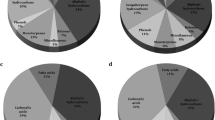Abstract
Males ofRhyssa persuasoria andMegarhyssa nortoni nortoni exhibit marked aggregation behavior prior to and during the emergence of females from host trees, and this has been linked with the secretion of an odorous liquid from the mandibular glands. The volatile components of these secretions were examined by combined gas chromatography-mass spectrometry. While both species contained 6-methylhept-5-en-2-one,M. nortoni nortoni was characterized by a series of alkyl spiroacetals andR. persuasoria contained 3-hydroxy-3-methylbutan-2-one. The same spiroacetals have previously been isolated from the mandibular glands of other Hymenoptera and have been directly associated with aggregation behavior in some species. The chemical and behavioral aspects of the two species are discussed.
Similar content being viewed by others
References
Baker, R., Herbert, R., Howse, P.E., Jones, O.T., Francke, W., andReith, W. 1980. Identification and synthesis of the major sex pheromone of the olive fly (Dacus oleae).J. Chem. Soc. Chem. Commun. 1980:52–53.
Bergström, G., Tengö, J., Reith, W., andFrancke, W. 1982. Multicomponent mandibular gland secretions in three species ofAndrena bees (Hym. Apoidea).Z. Naturforsch. 37c:1124–1129.
Blum, M.S. 1978. Biochemical defenses in insects, pp. 466–573,in M. Rockstein (ed.). Biochemistry of Insects. Academic Press, New York.
Brossut, R. 1978. Gregariousness in cockroaches and inEublaberus in particular.In R. J. Ritter (ed.) Chem. Ecol: Odour Commun. Anim., Proc. Adv. Res. Inst. Elsevier, Amsterdam, pp. 237–246.
Cavill, G.W.K., andFord, D.L. 1953. The chemistry of ants.Chem. Ind. (London) 351.
Cavill, G.W.K., Davies, N.W., andMcdonald, F.J. 1980. Characterization of aggregation factors and associated compounds from the Argentine ant (Iridomyrmex, humilis). J. Chem. Ecol. 6:371–384.
Cederberg, B. 1977. Chemical basis for defense in bumblebees.Proc. Int. Congr. Int. Union Study Soc Insects, 8th, Centre Agric. Publications, Wageningen, Netherlands. p. 77.
Crankshaw, O.S., andMatthews, R.W. 1981. Sexual behavior among parasiticMegarhyssa (Hymenoptera: Ichneumonidae).Behav. Ecol Sociobiol 9:1–7.
Davies, N.W. 1984. Determination and optimization of flow rates in vacuum capillary gas chromatography.Anal. Chem. 56:2618–2620.
Francke, W. 1984. Acetogenins in systems of chemical communication.Nova Acta Regiae Soc. Sci. Ups. C 3:119–126.
Francke, W., Heemann, V., andHeyns, K. 1974. Volatile substances from ambrosia beetles. I.Z. Naturforsch. 29c:243–245.
Francke, W., Heemann, V., Gerken, B., Renwick, J. A. A., andVité, J. 1977. 2-Ethyl-1,6-dioxaspiro-[4.4]nonane, principal aggregation pheromone ofPityogenes chalcographus (L.)Naturwissenschaften 64:590–591.
Francke, W., Hindorf, G., andReith, W. 1978. Alkyl-1,6-dioxaspiro-[4.5]decanes—a new class of pheromones.Agnew. Chem. Int. Ed. 17:862.
Francke, W., Hindorf, G., andReith, W. 1979. Mass spectrometric fragmentations of alkyl-1,6-dioxaspiro[4.5]decanes.Naturwissenschaften 66:619–620.
Francke, W., Reith, W., Bergström, G., andTengö, J. 1980a. Spiroketals in the mandibular glands ofAndrena Bees.Naturwissenschaften 67:149–150.
Francke, W., Reith, W., andSinnwell, V. 1980b. Determination of relative configurations of spiroacetals by [1H]- and [13C]NMR spectroscopy.Chem. Ber. 113:2686–2693.
Francke, W., Reith, W., Bergström, G., andTengö, J. 1981. Pheromone bouquet of the mandibular glands inAndrena haemorrhoa (Hym. Apoidea).Z. Naturforsch. 36c:928–932.
Francke, W., Mackenroth, W., Schröder, W., Schulz, S., Tengö, J., Engels, E., Engels, W., Kittman, R., andSchneider, D. 1985. Indentification of cyclic emolethers from insects: Alkyldihydropyranes from bees and alkyldihydro-4H-pyran-4-ones from a male moth.Z. Naturforsch. 40C: 145–147.
Heatwole, H., Davis, D.M., andWenner, A.M. 1963. The behavior ofMegarhyssa, a genus of parasitic hymenopterans (Ichneumonidae: Ephialtinae).Z. Tierpsychol. 19:652–664.
Hefetz, A., Eickwort, G.C., Blum, M.S., Cane, J., andBohart, G.E. 1982. A comparative study of the exocrine products of cleptoparasitic bees (Holcopasites) and their hosts (Calliopsis) (Hymenoptera: Anthophoridae, Andrenidae).J. Chem. Ecol. 8:1389–1397.
Kirk, A.A. 1975. Siricid woodwasps and their associated parasitoids in southeastern United States.J. G. Entomol. 9:141–144.
Madden, J.L. 1968. Behavioral responses of parasites to the symbiotic fungus associates withSirex nocitilio F. Nature 218:189–190.
Madden, J.L., andCoutts, M.P. 1979. The role of fungi in the biology and ecology of woodwasps, pp. 165–174.in L.R. Batra (ed.). Insect-Fungus Symbiosis. Allanheld, Osmun, and Co., Montclair, New Jersey.
Moore, B.P., andBrown, W.V. 1979. Chemical composition of the defensive secretion inDyschirius bonelli (Coleoptera: Carabidae: Scaratinae) and its taxonomic significance.J. Aust. Entomol. Soc. 18:123–125.
Mori, K., andTanida, K. 1981. Synthesis of three stereoisomeric forms of 2,8-dimethyl-1,7-dioxaspiro[5.5]undecane, the main component of the cephalic secretion ofAndrena wilkella.Heterocycles 15(2):1171–1174.
Regnier, F.E., andLaw, J.H. 1968. Insect pheromones.J. Lipid Res. 9:541–551.
Ryker, L.C., Libbey, L.M., andRudinsky, J.A. 1979. Comparison of volatile compounds and stridulation emitted by the Douglas-fir beetle from Idaho and western Oregon populations.Environ. Entomol. 8:789–798.
Silverstein, R.M., Brownlee, R.G., Bellas, T.E., Wood, D.L., andBrowne, L.E. 1968. Brevicomin. Principal sex attractant in the frass of the female western pine beetle.Science 159:889–891.
Stanley, G., andKennett, B.H. 1973. Reaction gas chromatography of microgram and submicrogram samples using sealed glass capillaries.J. Chromatogr. 75:304–307.
Taylor, K.L. 1967. The introduction, culture, liberation, and recovery of parasites ofSirex noctilio in Tasmania, 1962–1967. Division of Entomology Technical Paper 8, C.S.I.R.O., Canberra.
Tengö, J., andBergström, G. 1976. Comparative analyses of lemon-smelling secretions from heads ofAndrena F. (Hymenoptera, Apoidea) bees.Comp. Biochem. Physiol. 55B:179–188.
Tengö, J., Bergström, G., Borg-Karlson, A.K., Groth, I., andFrancke, W. 1982. Volatile compounds from cephalic secretions of females in two cleptoparasite bee genera,Epeolus (Hym. Anthrophoridae) andCoelioxys (Hym. Megachilidae).Z. Naturforsch. 37c:376–380.
Author information
Authors and Affiliations
Rights and permissions
About this article
Cite this article
Davies, N.W., Madden, J.L. Mandibular gland secretions of two parasitoid wasps (Hymenoptera: Ichneumonidae). J Chem Ecol 11, 1115–1127 (1985). https://doi.org/10.1007/BF01020679
Received:
Accepted:
Issue Date:
DOI: https://doi.org/10.1007/BF01020679




